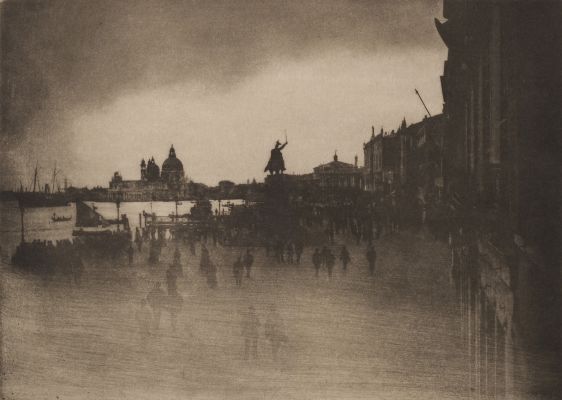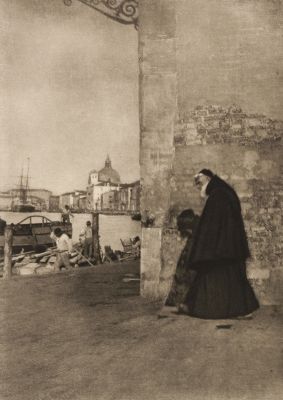
Title
On a Dutch ShoreArtist
Annan, James Craig (Scottish, 1864-1946)Key FigurePublication
Camera Work VIIIDate
1904Process
PhotogravureAtelier
T. & R. Annan & SonsImage Size
15 x 23 cm
Taken at the very beginning of his career, Annan’s On a Dutch Shore is of an auction, though this is not apparent from the evidence in the print. As a composition the crowd forms a dark shape balanced against the shape of the two boats, which are now turned seawards, into the wind. The group at the auction is engaged in an urgent and intense activity on which their livelihood depends. It is an eloquent photograph about a tiny group of people fighting to survive in a vast world of sea and sand and wind. Such a highly charged atmosphere, always quietly stated, pervades the very best of Annan’s work. [1]
On a Dutch Shore has immense riches. The pinken have discharged their catches. The group on the shore are engaged in its auction. This print shows the culmination of one of the cycles in the lives of these people played out with the wind, the sky and the sea. Not only that, it, too, offers a beautiful, sparse, abstract composition; the tight, dark rectangle of the crowd balanced against the triangles of the two idle boats. [2]
Reproduced / Exhibited
Buchanan, William. J. Craig Annan: Selected Texts and Bibliography. Oxford: Clio Press, 1994. fig. 17.
Buchanan, William, and J C. Annan. The Art of the Photographer: J. Craig Annan, 1864-1946. Edinburgh: National Galleries of Scotland, 1992. plate 3.
Haworth-Booth, Mark. The Golden Age of British Photography, 1839-1900: Photographs from the Victoria and Albert Museum, London [and Others]. New York: Aperture, 1984 170
Morrison-Low, A D, Julie Lawson, and Ray McKenzie. Photography 1900: The Edinburgh Symposium. Edinburgh: National Museums of Scotland and the National Galleries of Scotland, 1994. fig. 19.
Weaver, Mike. British Photography in the Nineteenth Century: The Fine Art Tradition. Cambridge [United States: University Press, 1989. p. 263.
References
[1] Weaver M Scottish Arts Council. The Photographic Art : Pictorial Traditions in Britain and America. 1St U.S. ed. New York: Harper & Row; 1986. p. 267
[2] http://journal.depthoffield.eu/cgi/t/text/text-idx?c=scherpte;sid=d65e07bc8c85e18efe09dbbe72358022;view=text;idno=m0301a03;rgn=div1;cc=scherpte;lang=nl;node=m0301a03%3A5






